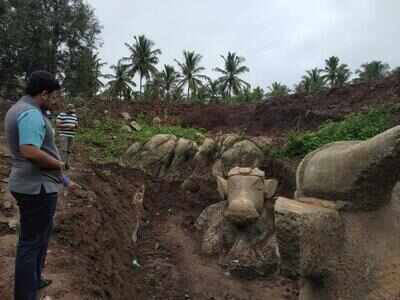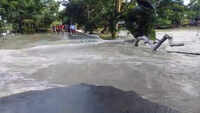
Mysuru: Accompanied by members of the Mysuru Heritage Committee and other conservationists, scion of the erstwhile Mysuru royal family Yaduveer Krishnadatta Chamaraja Wadiyar on Friday visited Arasanakere in Jayapura Hobli, Mysuru taluk, where two statues of Nandi, not very dissimilar to the one en route the summit of Chamundi Hills, were recently unearthed.
NS Rangaraju, member of the Mysuru Heritage Committee, who visited the spot, opined that the statues lay submerged in a lake in Jayapura. “I think that a lake must have submerged the statues around 50 years ago,” Rangaraju told TOI.
After chancing upon the two statues, which Rangaraju said were found buried in a 100mX100m area in Arasanakere, the villagers took it upon themselves to dig it out, and subsequently alerted the officials of the department of archaeology, museums and heritage, which has now taken possession of the two sculptures.
Besides Rangaraju, Swaroop Gopal Raj Urs and Namma Mysuru Foundation founder-trustee Dasarath accompanied Yaduveer to the site on Friday.
Rangaraju said that he had visited the site for the first time around a year ago in the company of former Mysuru zilla panchayat member Kumar. “I could discern the neck of one statue of Nandi at that juncture, but no other part of either sculpture could be clearly seen. Besides finding two statues of Nandi, we have found three others, which are however incomplete,” said Rangaraju.
On the type of stone used to sculpt the statues, he said that they had been carved out of metamorphic rock, which was not available everywhere. “Such stones are found mostly only in Mysuru and Hassan districts,” the heritage committee member said. On the government department taking the two statues into their custody, Rangaraju said, “The plot on which the statues were found is owned by an individual, but what is found underneath is the property of the government. Yaduveer, on being informed about the discovery of the two statues, consulted me. I told him that I would speak to the commissioner of the archaeology department.”
Sati stone found
NS Rangaraju, while accompanying Yaduveer who toured the village interacting with the residents of Arasanakere, found a Sati Stone – sculptures erected in the memory of woman who martyred themselves for a cause – nestled underneath a Peepal Tree. “On closer examination, I found that the sculpture mentioned the voluntary sacrifice of three wives. I brought this to Yaduveer’s attention, and he was very keen on ensuring its preservation for posterity. I think that the Sati Stone, belonging to the Hoysala era, dates back to either the 12th or the 13th century,” Rangaraju said.
NS Rangaraju, member of the Mysuru Heritage Committee, who visited the spot, opined that the statues lay submerged in a lake in Jayapura. “I think that a lake must have submerged the statues around 50 years ago,” Rangaraju told TOI.
After chancing upon the two statues, which Rangaraju said were found buried in a 100mX100m area in Arasanakere, the villagers took it upon themselves to dig it out, and subsequently alerted the officials of the department of archaeology, museums and heritage, which has now taken possession of the two sculptures.
Besides Rangaraju, Swaroop Gopal Raj Urs and Namma Mysuru Foundation founder-trustee Dasarath accompanied Yaduveer to the site on Friday.
Rangaraju said that he had visited the site for the first time around a year ago in the company of former Mysuru zilla panchayat member Kumar. “I could discern the neck of one statue of Nandi at that juncture, but no other part of either sculpture could be clearly seen. Besides finding two statues of Nandi, we have found three others, which are however incomplete,” said Rangaraju.
On the type of stone used to sculpt the statues, he said that they had been carved out of metamorphic rock, which was not available everywhere. “Such stones are found mostly only in Mysuru and Hassan districts,” the heritage committee member said. On the government department taking the two statues into their custody, Rangaraju said, “The plot on which the statues were found is owned by an individual, but what is found underneath is the property of the government. Yaduveer, on being informed about the discovery of the two statues, consulted me. I told him that I would speak to the commissioner of the archaeology department.”
Sati stone found
NS Rangaraju, while accompanying Yaduveer who toured the village interacting with the residents of Arasanakere, found a Sati Stone – sculptures erected in the memory of woman who martyred themselves for a cause – nestled underneath a Peepal Tree. “On closer examination, I found that the sculpture mentioned the voluntary sacrifice of three wives. I brought this to Yaduveer’s attention, and he was very keen on ensuring its preservation for posterity. I think that the Sati Stone, belonging to the Hoysala era, dates back to either the 12th or the 13th century,” Rangaraju said.
World Cup 2019
Trending Topics
LATEST VIDEOS
More from TOI
Navbharat Times
Featured Today in Travel
Quick Links
Lok Sabha Election Schedule 2019Lok Sabha Election NewsDelhi Capitals teamMI team 2019Rajasthan Royals 2019RCB team 2019Maharashtra Lok Sabha ConstituenciesBJP Candidate ListBJP List 2019 TamilnaduShiv Sena List 2019AP BJP List 2019Mamata BanerjeeBJP List 2019 MaharashtraPriyanka GandhiBJP List 2019 KarnatakaAMMK Candidate List 2019BJP List 2019 WBLok Sabha Elections in Tamil NaduBSP List 2019 UPNews in TamilLok Sabha Poll 2019Satta Matka 2018PM ModiMahagathbandhanNagpur BJP Candidate ListChandrababu NaiduTamil Nadu ElectionsUrmila MatondkarNews in TeluguMadras High CourtTejashwi YadavArvind KejriwalTejasvi SuryaPawan KalyanArvind KejriwalYogi AdityanathJaya PradaSatta King 2019Srinagar encounter
Get the app







